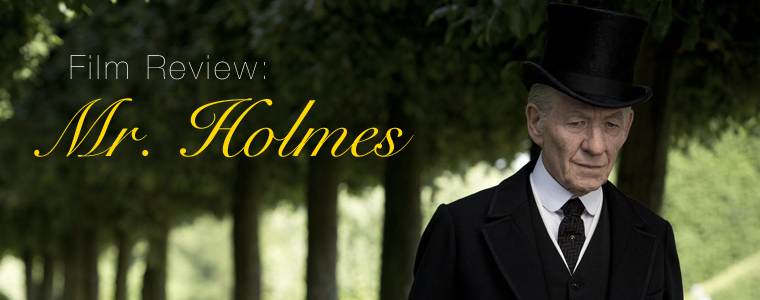Whatever Remains
by Andrew Collins
Like any good mystery, Mr. Holmes (released on DVD Nov. 10) is complex and multi-layered. Like any good story, the plot builds slowly and steadily in emotional intensity, like a rising swell that washes over us, weighty with revelations. It most likely won’t be the film you expect, but it most likely will be better than whatever it is you were expecting.
In Mr. Holmes we meet the retired, reclusive Sherlock (Ian McKellen) at age 93, a man removed in many ways – but not quite entirely – from the myth of the London sleuth that today’s generation has re-imagined. When the film begins, the year is 1947 and the Great Detective is just returning from a trip to Japan, where he sought a rare plant to help sharpen his mind in hopes of remembering why his last case drove him to quit detective work.
Pressed by a Japanese admirer about why he isn’t wearing the famed deer hunter hat, he says it’s an embellishment of Dr. Watson’s. “I’ve never worn one.”
And the pipe?
“I prefer a cigar.”
Nor is the celebrated 221B Baker Street his actual address, but a fiction to keep nosy fans at bay. “Mostly Americans.”
The rest of the usual suspects in a Sherlock Holmes story – particularly Dr. John Watson and Mycroft Holmes – linger out of sight, but cast long shadows into this tale. Mycroft actually appears, but only in a flashback. Only Sherlock remains, alone with the mementos of his departed – a silk glove in a hidden drawer here, a box of old books there. They linger like ghosts, memories of his past life and touchstones for the audience’s imagination. A friend remarked to me after the film, “I got chills every time they mentioned Dr. Watson.”
The blazing intellect and near-religious devotion to logic and rationality that we love in the classic Sherlock are still present in this iteration of the character (when they manage to protrude through his senility). But the “real” Sherlock Holmes this film presents to us is Sherlock the human being, weighed down by regrets and burdened in the present by the unlikely friendship he strikes up with his caretaker’s son and an ebbing colony of bees.
In the end, Mr. Holmes isn’t really about the whodunit thrill of one last mystery. It’s about learning there are more important things in life than getting the facts right. This realization comes to the elderly Sherlock through several critical junctures, the most powerful of which takes place in a flashback to his visit in Japan:
Sherlock is speaking to his host about how he has little time for fictionalized stories and instead prefers “the facts.” Suddenly, across the street he notices a young woman, half of her face horrifically scarred. She flicks him a modest acknowledgement and hurries on her way. The camera pans up to a sign for Hiroshima station. The “facts” are that a certain square mileage of that city was demolished and a particular number of people killed when the atomic bomb struck, with political ramifications leading to the end of World War II. But that scarred woman, the charred landscape of the dead city, the mourners that haunt it? As Sherlock himself might say: “different thing entirely.”
The mastering deduction and the intricacies of human psychology can accomplish a lot of things in this world, but they can’t unravel the mysteries of the soul.
This is the lesson of Sherlock’s last mystery. The logic of modernism simply will not suffice as an answer to human tragedy. In those raw moments, only another soul will do.








